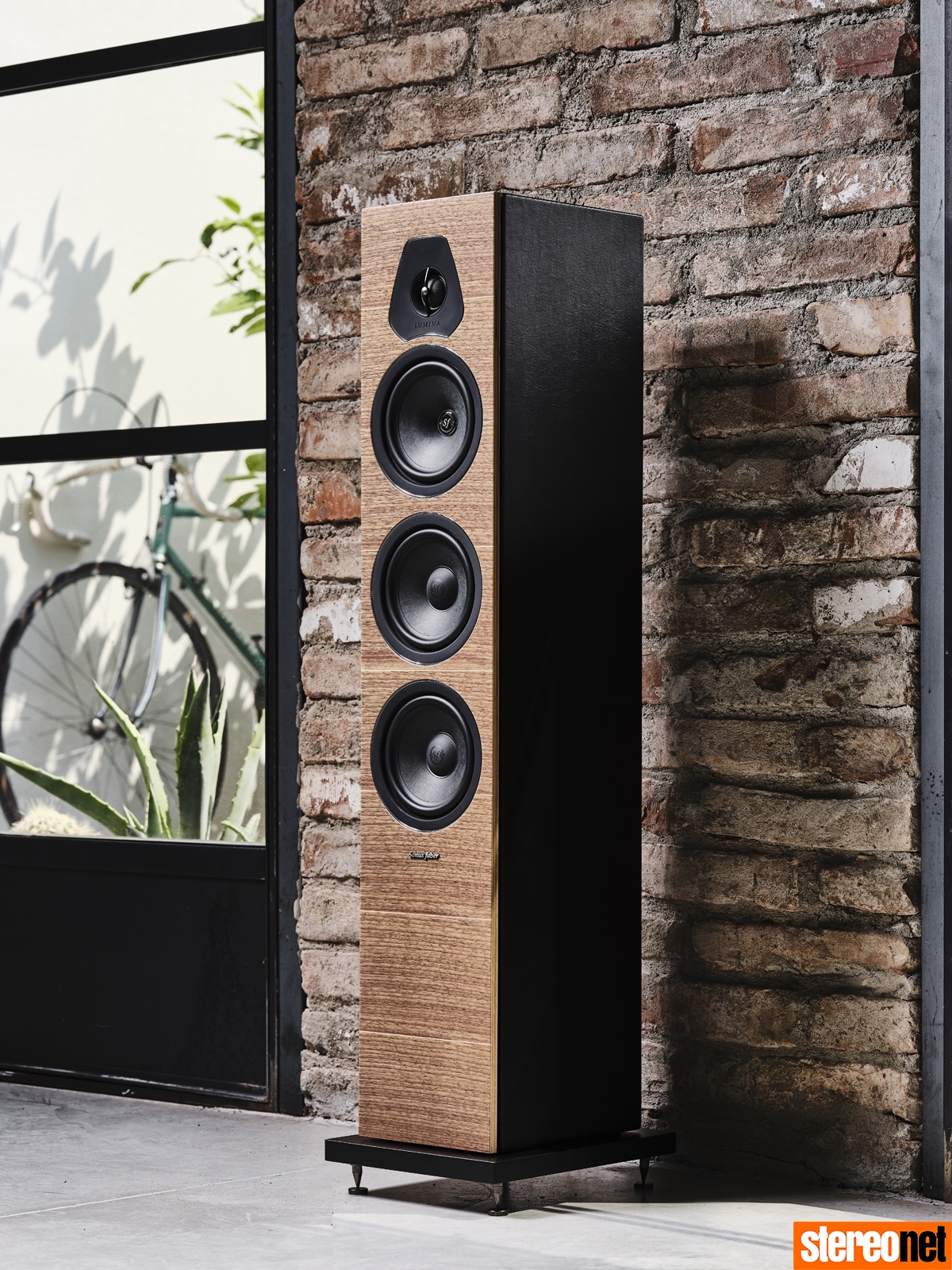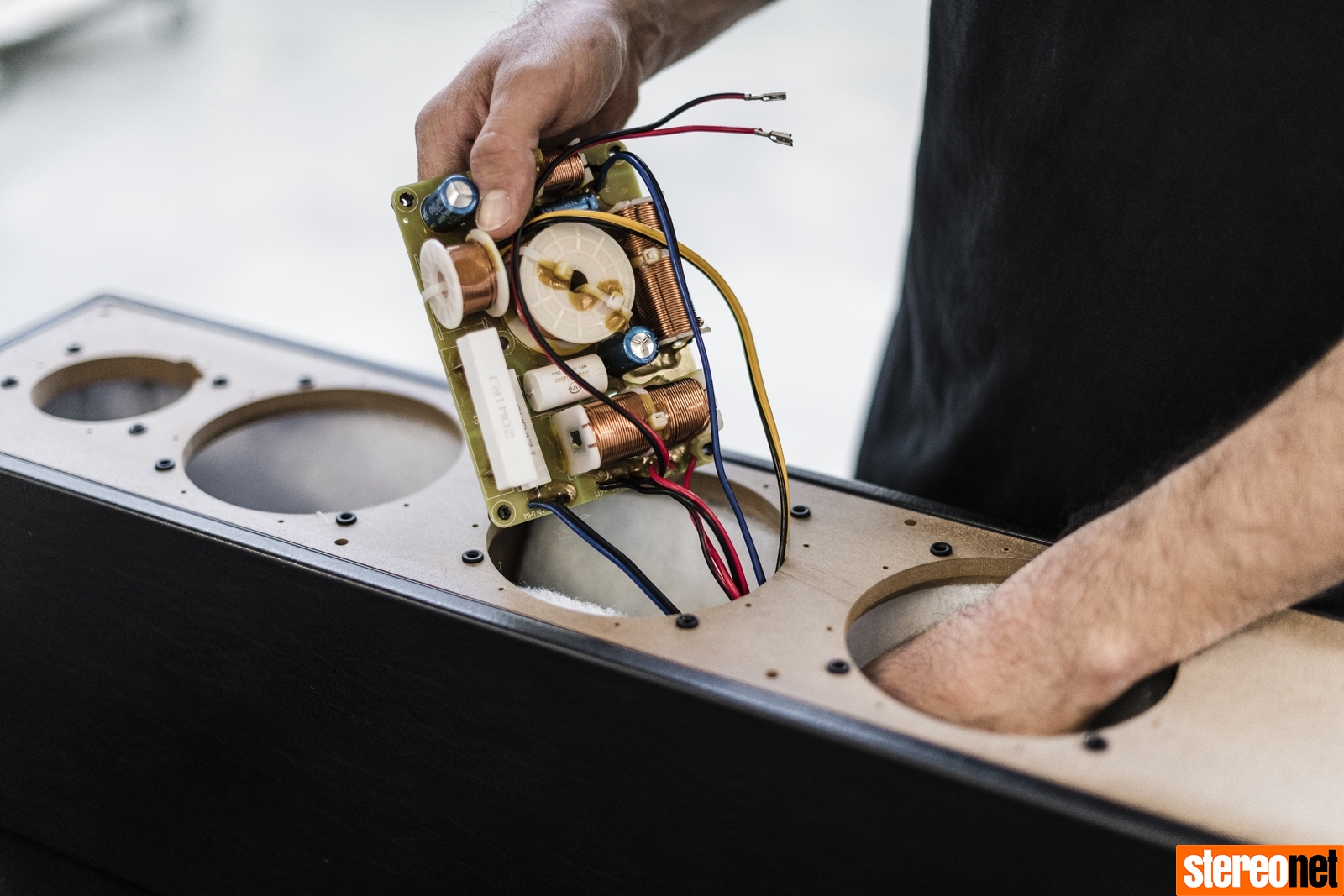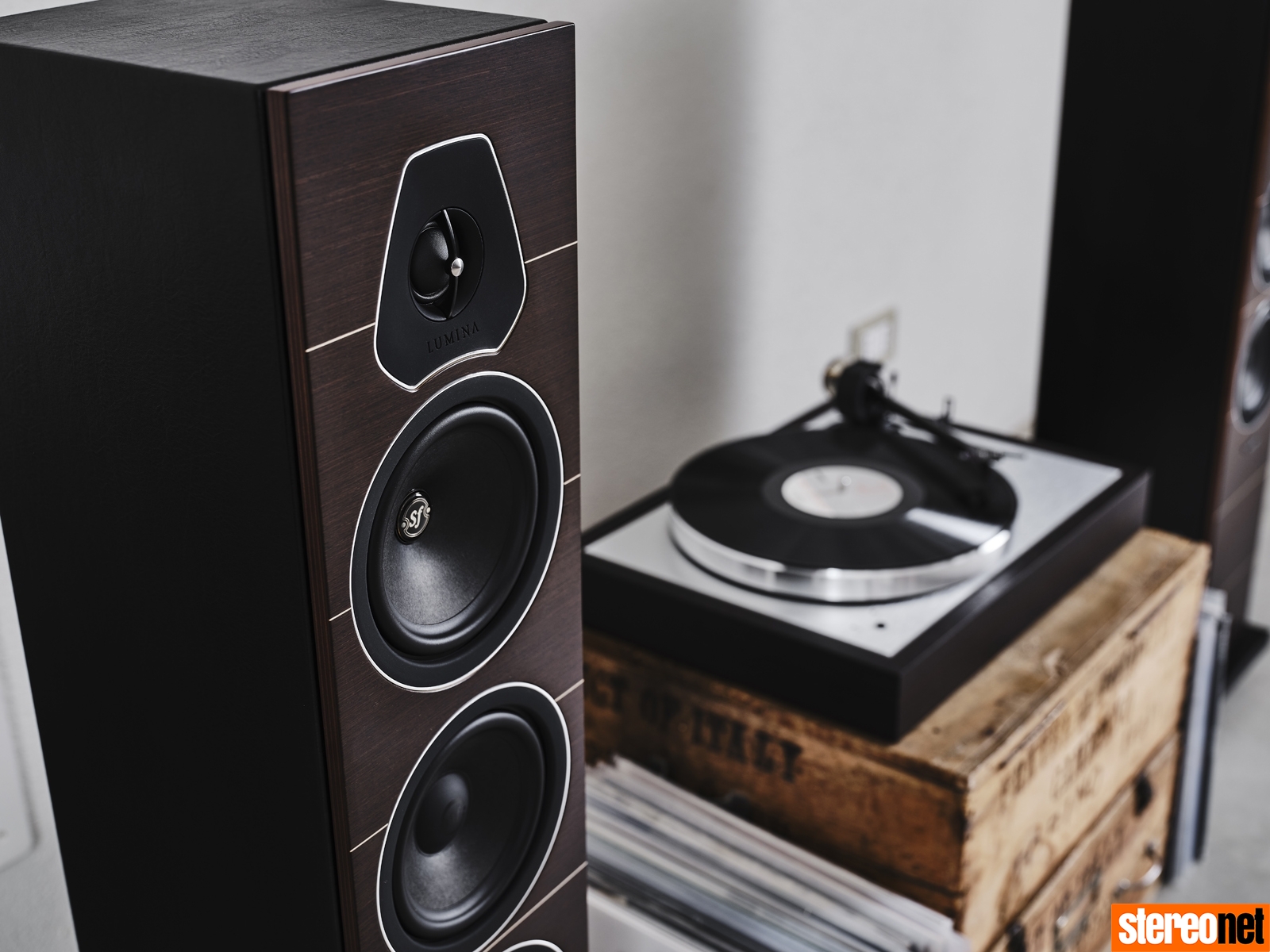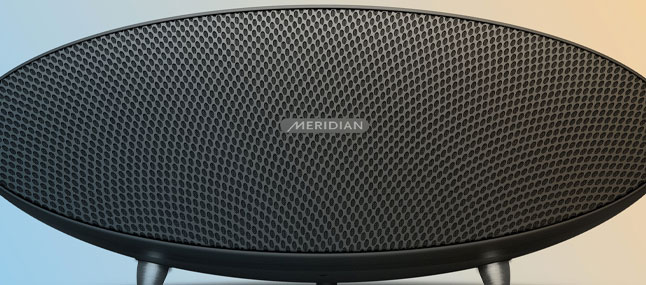Sonus faber Lumina III Floorstanding Loudspeakers Review

Jay Garrett sees the light with this entry-level Italian floorstanding loudspeaker…
Sonus faber
Lumina III Floorstanders
AUD $3,995 RRP

Speaker manufacturers are forever trapped between the devil and the deep blue sea. If you've made your name building affordable designs and suddenly decide to go all-out with a cost-no-object product, then you'll doubtless receive cries of “how much?” Conversely, if you're a premium brand – famous for using luxurious woods for your handcrafted cabinets and fitting fancy drive units – and you opt to move downmarket, you run the risk of damaging the brand as you bring more customers into the fold. Some might even see it as letting the riff-raff into a hitherto exclusive club…
That's the vista that Sonus faber faces with its new affordable, entry-level loudspeaker range. The marque needs little, if any, introduction or explanation – all serious audiophiles will know of it, and why it has been so illustrious over the years. Now, with the new Lumina III loudspeaker tested here, we have the opportunity to taste the lower-hanging fruits of the great and the good. The entry-level investment buys you a largish floorstander, similar – superficially at least – to the more up-market Sonetto III but a good deal less expensive.

FAMILY AFFAIR
So something has to give, right? Well, the elegant curves of the higher collections are replaced by right-angles, but this is a company that would not allow a product to leave the workshop looking anything less than molto bello. I could, then, wax lyrical about the multi-layered wood baffle construction and the oh-so-attractive finish of the maple-inlaid, wenge-fronted model I have sat in front of me here. Note to self: Remember that it is – first and foremost – an affordable floorstanding loudspeaker rather than an object d'art.
Down to brass tacks, and the new Lumina III is a three-way floorstanding, reflex ported design that measures 989x228x278mm and weighs 15.9kg. It features the Italian brand's custom drivers throughout, including a 29mm high definition DAD design with a Kurtmueller hand-coated soft silk diaphragm, as seen in the Sonetto. Also borrowed from the more expensive speaker is the 150mm cone midrange driver, with an ultra-free compression basket. This features a custom diaphragm made from air-dried cellulose pulp and other natural fibres. Not something you'd generally expect from an entry-level loudspeaker, but there you go…

Joining the drivers from its more expensive stablemate are a pair of 150mm woofers, specially designed for Lumina floorstanders. Again, the same ultra-free compression basket is employed along with a blend of traditional cellulose pulp and other natural fibres. These have been developed for high linearity as well as sonic coherence with the midrange unit, and are managed by the company's own crossover network. This is an anti-resonant design said to have an optimised amplitude/phase response for the best space/time performance. It also features what the brand calls its Paracross topology, a means of impedance compensation at low frequencies, making the loudspeaker more amplifier-friendly. Here you'll also find Sonus faber branded capacitors. Rounding things off is a downward-firing reflex port, just above the Lumina's integral plinth which stands on four spikes that come with floor-protecting shoes, to use if you so wish.

The result is a fairly standard box construction fitted with drive units from the higher end Sonetto series, matched with a pair of custom-designed woofers, set into an attractively figured faux leather-wrapped wooden baffle. There are certainly enough quality touches here to satisfy me that this is a Sonus faber loudspeaker, albeit one that's less lavish than usual. Looking around the tower, I couldn't find anything that would give away this speaker's standing in the Italian maker's model hierarchy. Could this be because the new Lumina series is made in the same Italian workshop as the upper-echelons of Sonus faber, with a choice of black, wenge and walnut finishes?
The manufacturer claims a frequency response of 40Hz to 24kHz, although – as is the fashion these days – unhelpfully does not quote cut-off points. Sensitivity is put at 89dB, which isn't bad for a speaker of this size, but nothing special. Nominal impedance is said to be 4 ohms, so you'll need a gutsy solid-state amplifier to really get the best out of them; the company suggests a recommended amplifier power of between 50W and 250W. Crossover frequencies are 350Hz and 3.5kHz, keeping things nicely equidistant from where the ear is at its most sensitive.

SOUND QUALITY
So if it looks like a Sonus faber and feels like a Sonus faber, does it sound like one? The short answer is yes, but whereas the Sonetto was undoubtedly a brave move for the brand that brought a much more flexible range to the company's product portfolio, the Lumina III has a more roguish character. Could it be down to the leather jacket that its cabinet is wearing?

The damped apex dome tweeter and natural fibre midrange driver have been dubbed “the voice of Sonus faber” for a good reason. Queueing up The Sundays' album Reading Writing and Arithmetic over Roon via my Oppo UDP-205, and Harriet Wheeler's smooth vocals instantly set the scene. Key was the well mannered and extended treble, plus a refined openness to the midband. That said, I did get a sense that the Lumina III was leaning more forward in the soundscape than its stablemates; there was a greater sense of urgency and bite. Indeed you could almost call it aggression, on this rather forward early nineties indie-pop recording.
Bass is both fast and dynamic. This isn't like Sonus faber speakers of a decade or so ago, when they sounded lovely but not particularly lithe. Geddy Lee's bass guitar on Rush's Freewill punched through, the twin woofers aided and abetted by that down-firing port which also makes positioning these floorstanders easier than your average rear-ported design. Also, solid and dynamic as the low-end was, what really pleased me was its innate sense of fun. It was bouncy and supple, capturing the rhythms of this seminal seventies rock track. It would have been easy to load this speaker with bass that plumbed the depths, but instead, it's been given a bottom end that's all about speed and tactility.

Long term fans of the brand know that Sonus faber speakers have always been great with classical music, but feed them thrash metal and in the old days they'd have run a mile. Not now though, as Testament's Souls of Black showed; the Lumina III is a different animal altogether. The opening bass work of Steve Di Giorgio rang through my listening room as the track crunched away before me; there was no doubt as to whether this speaker likes to party. Admittedly this comes at the price of losing some of the company's famous refinement – something you hear on the slightly darker sounding Olympica for example – but this speaker is aimed at a younger and more energetic audience.
Its soundstage proved spacious and well-judged, allowing Tool's Schism to stretch out in space. The five musicians got lots of room in the expansive mix, and there was enough detail for the intricate rhythms and interweaving lines to be presented intelligibly to the listener. It wasn't quite able to dig out the hard-to-reach microdynamics at the back of the sonic sofa, but this is a speaker that's arguably built for listeners of more contemporary artists. At the same time, the Lumina III's sense of scale was welcome with Bach's Brandenburg Concerto No. 3 in G major which again proved just how good the treble and midband drivers are. Strings had a fine sense of body, as well as a pleasing tonal sheen that didn't get too harsh or brittle.

THE VERDICT
 It would be simplistic to argue that Sonus faber's new Lumina III is the wild child of the family, even though there is some evidence to support that contention. Yes, this speaker does seem to prefer the amplified and electronic over the orchestral, yet the proverbial apple never falls far from the tree. There's still a degree of refinement and breeding here that makes this floorstander stand out from similarly priced offerings from less esoteric brands. Factor in the design's attention to detail – something that Sonus faber is renowned for – and it's hard not to like at the price. So, if you're looking for a loudspeaker from a prestige brand that retains its style but not its price tag, then go and listen to this.
It would be simplistic to argue that Sonus faber's new Lumina III is the wild child of the family, even though there is some evidence to support that contention. Yes, this speaker does seem to prefer the amplified and electronic over the orchestral, yet the proverbial apple never falls far from the tree. There's still a degree of refinement and breeding here that makes this floorstander stand out from similarly priced offerings from less esoteric brands. Factor in the design's attention to detail – something that Sonus faber is renowned for – and it's hard not to like at the price. So, if you're looking for a loudspeaker from a prestige brand that retains its style but not its price tag, then go and listen to this.
For more information visit Sonus faber
Jay Garrett
StereoNET’s resident rock star, bass player, and gadget junkie. His passion for gadgets and Hi-Fi is second only to being a touring musician.
Posted in:Hi-Fi Loudspeakers Floor Standing Applause Awards 2020
Tags: sonus faber synergy audio visual
JOIN IN THE DISCUSSION
Want to share your opinion or get advice from other enthusiasts? Then head into the Message Forums where thousands of other enthusiasts are communicating on a daily basis.
CLICK HERE FOR FREE MEMBERSHIP
Trending
applause awards
Each time StereoNET reviews a product, it is considered for an Applause Award. Winning one marks it out as a design of great quality and distinction – a special product in its class, on the grounds of either performance, value for money, or usually both.
Applause Awards are personally issued by StereoNET’s global Editor-in-Chief, David Price – who has over three decades of experience reviewing hi-fi products at the highest level – after consulting with our senior editorial team. They are not automatically given with all reviews, nor can manufacturers purchase them.
The StereoNET editorial team includes some of the world’s most experienced and respected hi-fi journalists with a vast wealth of knowledge. Some have edited popular English language hi-fi magazines, and others have been senior contributors to famous audio journals stretching back to the late 1970s. And we also employ professional IT and home theatre specialists who work at the cutting edge of today’s technology.
We believe that no other online hi-fi and home cinema resource offers such expert knowledge, so when StereoNET gives an Applause Award, it is a trustworthy hallmark of quality. Receiving such an award is the prerequisite to becoming eligible for our annual Product of the Year awards, awarded only to the finest designs in their respective categories. Buyers of hi-fi, home cinema, and headphones can be sure that a StereoNET Applause Award winner is worthy of your most serious attention.






